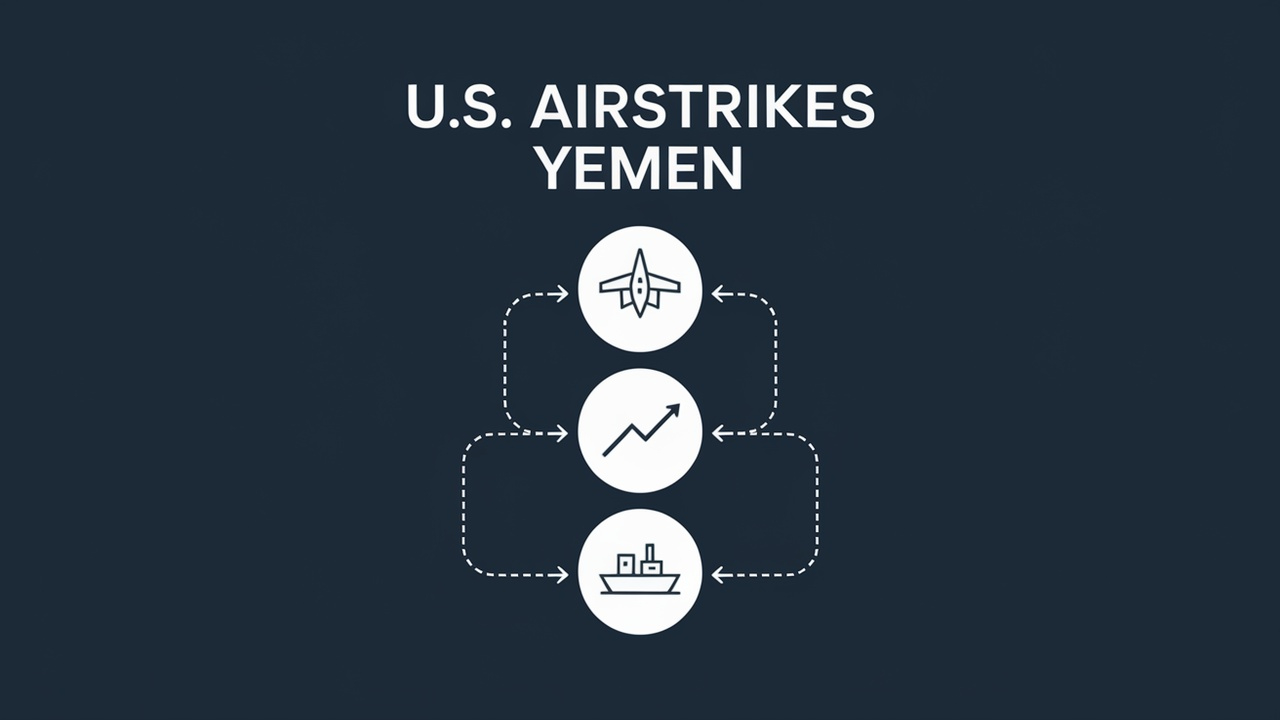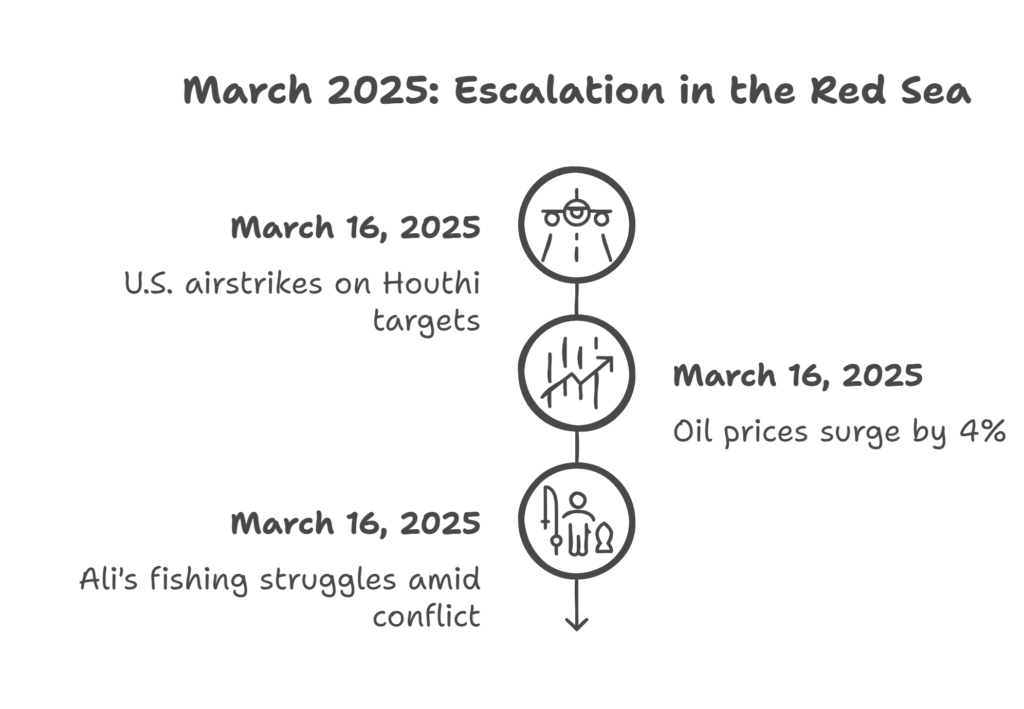Oil Prices Rise Amid U.S. Commitment to Continued Airstrikes on Yemen’s Houthis
The air smelled of diesel and salt. In Aden, Yemen, 34-year-old fisherman Ali Mansour stood on the cracked wooden deck of his boat, staring at the horizon.

The Red Sea shimmered under the March sun, but his nets stayed empty. “The ships don’t come anymore,” he said, his voice low, cracked from days of shouting over the wind. Far beyond his boat, U.S. jets roared, striking Houthi targets. On March 16, 2025, oil prices climbed again—up 4%—as America doubled down on airstrikes. For Ali, it’s not just news. It’s survival.
The Turning Point
It started Saturday night. U.S. and allied forces hit seven Houthi-controlled spots in Yemen. The strikes killed 31, Yemen’s Houthi Health Ministry said. They were payback for a Houthi attack on the USS Harry S. Truman, a U.S. aircraft carrier in the Red Sea. The Houthis claimed they fired 18 missiles and a drone. The U.S. called it a lie—no damage confirmed. But the message was clear: this war isn’t slowing down.

Oil markets jolted awake. Brent crude spiked to $80 a barrel. West Texas Intermediate hit $75. Analysts pointed to the chaos. Shipping lanes—vital for 40 million containers a year—shut down. Companies like Maersk rerouted around Africa, jacking up costs. Ali felt it too. “Fish don’t care about oil,” he said. “But buyers do.”
Voices From The Community
In Sanaa, 28-year-old shopkeeper Fatima Hassan wiped sweat from her brow. Her shelves sat half-empty. “Everything costs more now—bread, rice, fuel,” she said. “The planes fly, and my kids go hungry.” The U.S. says it’s protecting trade. Fatima sees only loss.
Across the sea in Houston, Texas, truck driver Mike Torres filled his rig. Gas prices ticked up again—$3.50 a gallon, the highest since December. “I drive 500 miles a day,” he said. “This Yemen mess? It’s hitting my wallet.”
The People Behind The Story
Ali Mansour fishes to feed his wife and three kids. He’s weathered storms, but this feels different. “The sea used to give us life,” he said. “Now it’s a battlefield.”
Fatima Hassan runs her shop alone since her husband died in a 2023 drone strike. She’s tough, but the rising prices test her.
Mike Torres, a 42-year-old dad, hauls freight across Texas. He’s watched fuel costs creep up since January. “I can’t keep up,” he admitted.
Yahya Saree, the Houthi spokesperson, stands firm in Sanaa. He’s the voice promising revenge, rallying fighters against the U.S.
Timeline of Events
- October 2023: Houthis begin attacking Red Sea ships, backing Gaza.
- December 2024: USS Harry S. Truman arrives; Houthis claim five strikes.
- March 15, 2025: U.S. airstrikes hit Yemen, killing 31.
- March 16, 2025: Houthis say they hit the Truman; oil prices jump 4%.
- March 17, 2025: Trump vows “lethal force”; markets brace for more.
Community Impact
The ripples spread fast. In Yemen, fishing villages like Ali’s sit quiet. No buyers, no income. Markets in Sanaa thin out as prices soar. Families skip meals.
In the U.S., drivers like Mike feel the pinch. Gas stations flash higher numbers daily. Truckers pass costs to stores. Shoppers grumble at checkout.
Shipping firms warn of delays. Goods from Asia to Europe take weeks longer. Shelves might empty soon. “It’s a slow bleed,” one analyst said.
Behind The Scenes
Few saw this coming. Sources say Trump’s team pushed the Pentagon for bigger strikes after the Houthi claim. “He wanted a show of strength,” an insider whispered. The carrier stayed safe, but the message landed hard.
In Yemen, Houthi leaders met in secret bunkers Sunday. They knew the U.S. wouldn’t back off. Saree’s TV speech was taped hours earlier, edited to sound bold. “They’re scared,” a local trader guessed. “But they won’t admit it.”
Visual Journey
Picture Aden at dawn. The sky glows orange, streaked with jet trails. Ali’s boat bobs on choppy waves, nets tangled and dry. Seagulls circle, their cries sharp against the hum of distant engines.
In Sanaa, dust swirls through Fatima’s shop. Her kids play in the back, laughing over a cracked toy. Outside, a truck rumbles by, its horn blaring. The air tastes bitter—smoke and worry mixed.
Houston’s highways stretch wide under a gray sky. Mike’s rig gleams with dew. Gas pumps beep, numbers flashing red. A lone crow hops across the lot, pecking at crumbs.
Lessons Learned
Ali sighed. “I learned the sea doesn’t care who fights. I just want my fish back.”
Fatima’s eyes hardened. “You can’t trust promises. Only what’s in your hands.”
Mike shrugged. “I learned to fill up early. Prices don’t wait.”
For Yahya Saree, it’s defiance. “Every bomb teaches us to hit back harder,” he told his followers.
Wider Context
This isn’t just Yemen’s war. Oil prices tie the world together. The Red Sea carries 12% of global trade. When it shuts, everyone pays. In 2024, Houthi attacks sank two ships. Now, with U.S. jets overhead, the stakes climb.
Iran looms large. Trump blames them for arming the Houthis. Experts warn of a bigger clash. If oil hits $90, inflation could spike. Grocery bills, gas tanks, shipping fees—all jump.
Climate adds irony. Oil burns hotter as renewables lag. A fisherman, a shopkeeper, a trucker—they’re all caught in this web.
One Voice Stands Out
Ali stood on his boat, the sun dipping low. His hands gripped the rail, rough from years at sea. “I don’t know planes or oil,” he said. “I know my kids need food. When will this end?”
His question hung there, unanswered. The jets roared again. Oil prices ticked up. The world watched, waiting.